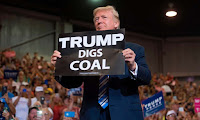 The conservative philosophy of allowing an unregulated free market to operate unfettered often seems to fall by the wayside when the Republican Party’s industry allies are failing to compete in the marketplace. Trump’s Energy Secretary Rick Perry recently provided a stark example of this philosophical flexibility when he proposed to effectively pull the failing coal industry out of the marketplace and instead prop it up with taxpayer-funded subsidies.
The conservative philosophy of allowing an unregulated free market to operate unfettered often seems to fall by the wayside when the Republican Party’s industry allies are failing to compete in the marketplace. Trump’s Energy Secretary Rick Perry recently provided a stark example of this philosophical flexibility when he proposed to effectively pull the failing coal industry out of the marketplace and instead prop it up with taxpayer-funded subsidies.Trump’s proposed coal bailout
The Trump administration has made no secret of its love for the coal industry. However, that industry has been losing badly in the free market, due largely to its inability to compete with cheaper natural gas and renewables. That was in fact the finding of Perry’s own Energy Department’s report, published just 3 months ago. The report also concluded:
Most of the common metrics for grid reliability suggest that the grid is in good shape despite the retirement of many baseload power plants … The power system is more reliable today due to better planning, market discipline, and better operating rules and standardsPerry’s new proposed rules directly contradict his department’s report, claiming “the resiliency of the electric grid is threatened by the premature retirements of these fuel-secure traditional baseload resources.” Perry tried to shift the goalposts from reliability to “resiliency” of the electric grid, essentially arguing that we need power plants that can store 90 days’ worth of fuel (i.e. huge piles of coal) to ensure that the grid remains “resilient.”
However, Perry also made the mistake of referencing the 2014 Polar Vortex to try and support this argument. The cold temperatures associated with that weather pattern caused electricity demand to spike, but as experts have noted, while wind energy produced above expectations during the Polar Vortex, coal power failed (emphasis added):
However, [Perry’s proposal] conveniently fails to mention that nearly 14 gigawatts (GW) of coal capacity was forced offline during the Polar Vortex, roughly 25 percent of all coal capacity in [the region]. 1.4 GW of nuclear was forced offline as well. Most of these generator outages were due to temperatures below the operating limit of power plant equipment ... Additional coal capacity was unavailable due to frozen coal piles.Perry’s argument is so ludicrous that it bears repeating. He claims that we need to subsidize huge coal piles to ensure grid resiliency to extreme events like the Polar Vortex. But during the Polar Vortex, coal plants were shut down because they couldn’t operate at such low temperatures, and because their big coal piles were frozen. And this isn’t the only example of grid resiliency without coal – during Hurricane Harvey, coal piles were too wet to be transported to power plant boilers. During record heat waves this summer, California’s grid proved reliable as a result of factors like renewables and energy storage, not coal.
It’s abundantly clear that the Trump administration is looking for an excuse to prop up the failing coal industry, because they’ve made it a cog in their culture wars. And so Rick Perry ignored the findings of his own department’s grid reliability report and made up some nonsense about how we need huge piles of coal to justify giving the industry a bailout in the form of taxpayer-funded subsidies.
Big Oil is also dependent on taxpayer subsidies
Along similar lines, a new study published in Nature Energy found that at current oil prices of $50 per barrel, about half of not-yet-developed oil fields are only profitable if the industry receives subsidies to pay for them. Worse yet, the oil industry pockets most taxpayer subsidy dollars in the form of profits:
At the price of US$50 per barrel, we find that a bit more than half (53%) of subsidy value (in net present value terms) goes to projects that would have proceeded anyway. That fraction rises to nearly all (98%) of subsidy value at US$100 per barrel. As others have found, regardless of the oil price, the majority of taxpayer resources provided to the industry end up as company profits.Oil would obviously only be extracted from a given field if doing so would yield a profit; otherwise it would stay in the ground until something changed to make its extraction profitable (like taxpayer subsidies or higher oil market prices).
To meet the Paris climate target, the US has a budget of 30 to 45 billion tons of carbon dioxide pollution allowed by 2050. At the current price of $50 per barrel, the oil industry subsidies would make an additional 17 billion barrels’ worth of oil reserves profitable, resulting in another 6 billion tons of carbon dioxide pollution. That would eat up 13 to 20% of America’s carbon budget.
Another report by Oil Change International found that American taxpayers are footing the bill for $20 billion in direct fossil fuel industry subsidies every year. That’s about $80 per year per American taxpayer.
Read more at Trump’s Plan to Bail Out Failing Fossil Fuels with Taxpayer Subsidies Is Perverse
No comments:
Post a Comment